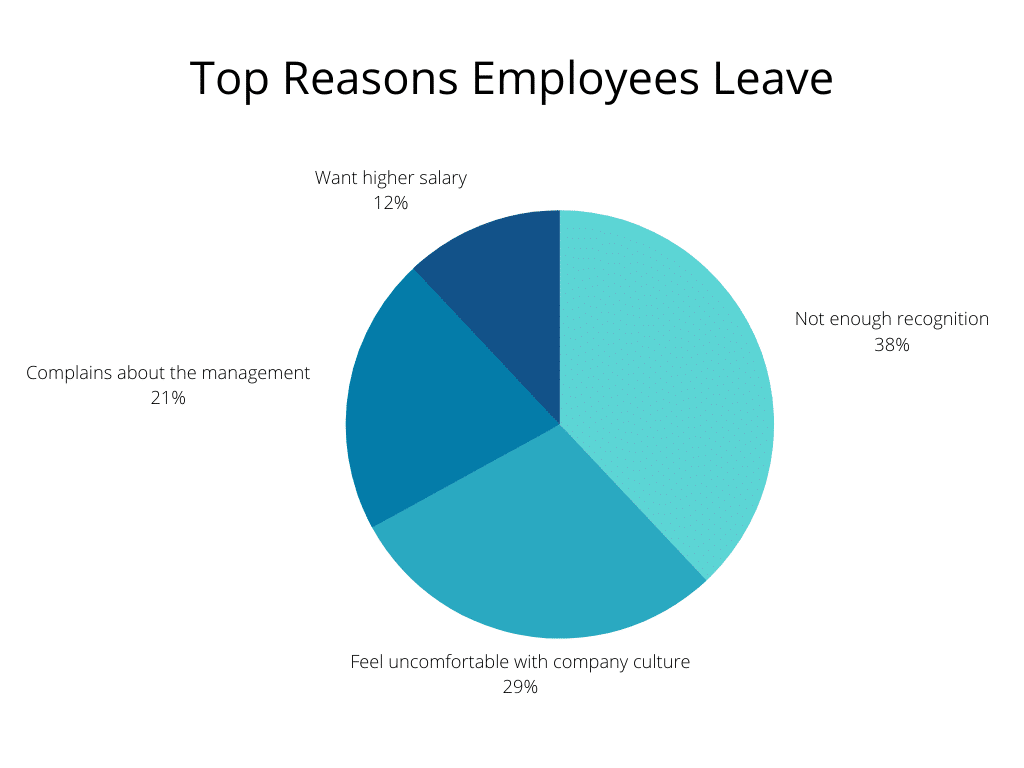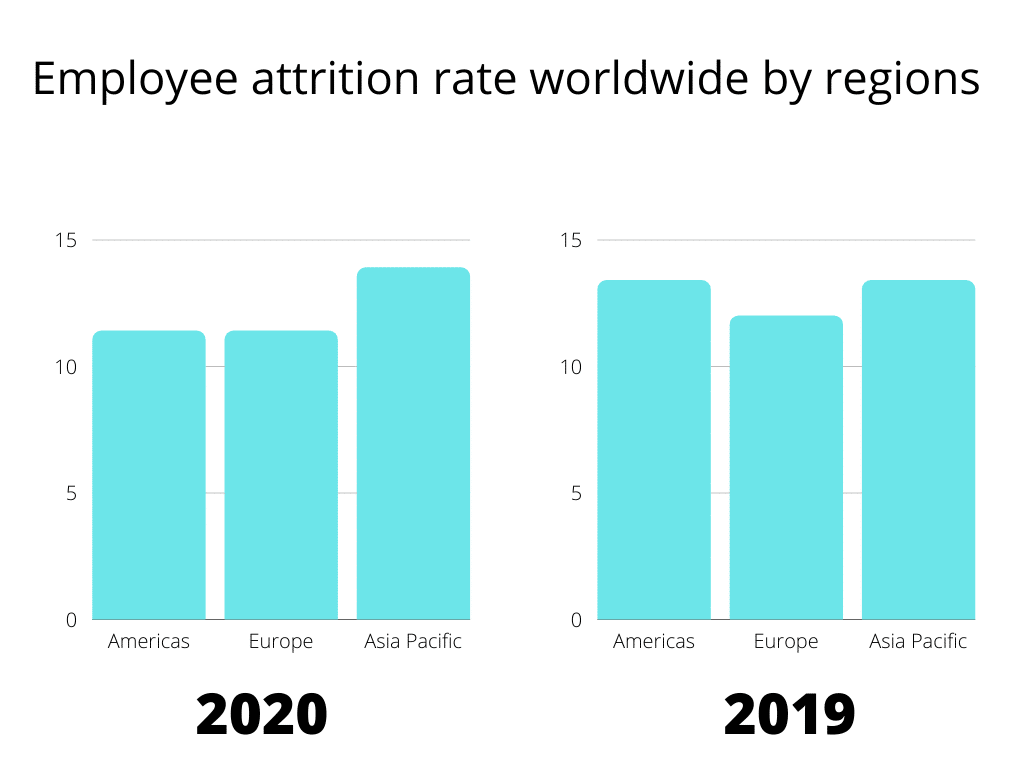How to Decrease Attrition Rate with the Help of Outsourcing Companies
Attrition is the continuous voluntary (e.g., resignation) or involuntary (e.g., retirement) termination of employment without replacements. As a result, specific positions are either left vacant or completely removed from the company.
Certain situations have been found to be more prone to attrition. For example, if you hire a freelance developer, there is always the possibility that they will leave your company without notice or will not be productive enough for one reason or another, which could result in their employment being terminated. However, when you work with an outsourcing company, you can be confident that they will take good care of your developer and create the necessary environment and company culture to promote productivity and retain talent.
Saving your company from the negative effects of a high attrition rate can be a daunting task at times. Organizations must frequently take specific steps to achieve a lower rate of attrition. Because outsourcing companies keep a close eye on their employees, their needs and challenges are easily identified and addressed, which keeps the employee happy, promotes output, and reduces the possibility of resigning or being fired.
In this post, we will talk about outsourcing and why it is one of the most effective remedies to the problem of high attrition rate.
Understanding Positive and Negative Attrition
Positive attrition occurs when unwanted or unproductive employees continuously resign or relieve their duties by a company. For example, when an unprofessional, unskilled employee leaves a company and is not replaced.
Negative attrition in business occurs when an organization slowly loses impactful and needed workforce members to factors like relocation, resignation, a lack of appreciation, or ailments. For example, having trained staff continuously resign and not providing adequate replacements for them.
From the above explanation, we can deduce that not all attrition is bad attrition.
What Factors Contribute to Employee Attrition?
The main driver of attrition is an undervalued workforce. When employees feel undervalued, they lose enthusiasm and motivation to work. This loss of enthusiasm will dampen the general workforce morale and affect output, leading to a steady termination of employment or multiple staff resignation.
Inadequate training results in low skill and productivity, which can also cause attrition. When an employee cannot deliver on their responsibilities, the organization they work for is forced to terminate their contract.
However, investing the right amount of time and resources in employee training programs produces a skilled and professional workforce which ultimately improves staff retention and reduces attrition.
Another cause of attrition worth mentioning is inadequate planning. Organizations should put proper planning and execution into the replacement of staff. For example, when a high-ranking, well-experienced staff member is retiring from a position, there should be plans in place to fill that position with an equally qualified person.
The absence of adequate contingency plans will leave roles open and unoccupied for long periods after staff retire or resign.
A Toxic workspace is another leading cause of attrition. It sometimes doesn’t matter that the staff body is skilled enough, effective enough, or compensated enough. An organization with toxic traits like segregation or an abusive boss will experience a high rate of attrition.
Finally, a lack of career growth opportunities could also lead to attrition. Ambitious employees who feel stunted in an organization or position due to the current unavailability of developmental prospects or an utter lack thereof will look for other opportunities that satisfy the longing they have to advance their careers.

What is Employee Turnover
Employee turnover refers to the rate or percentage of employees that have left the company. It also includes personnel that have been replaced with new employees. Employee turnover can be voluntary or involuntary as the case may be and involves several underlying factors. According to a 2019 North America Mercer Turnover Survey, the average voluntary turnover rate in the United States of America was 15% while that for involuntary turnover was 6%. However, there was an average turnover rate of 22%.
As seen on Monster, the average staff turnover rate was 15%. In a similar vein in 2019, a study in the UK by XpertHR, grouped the average turnover rates by occupation in an attempt to compare and contrast the relative differences in employee turnover according to occupations. This saw HR alongside Distribution and Education emerging top contenders with the highest turnover rates.
Also, careful analysis showed that General management and Administration had the lowest turnover rates which can be attributed to the fact that these areas require less career motivated work, and also because employees are more likely to stay with one particular company while working their way up the career ladder, rather than looking around for new employment opportunities.
Why Do Some Companies Have High Employee Turnover?
According to a source, employee turnover is experienced across all sectors globally, with the lack of advancement opportunities being the leading cause. Another reason why some companies experience high turnover is a lack of employee appreciation. Information on Forbes says that 66% of employees would quit their jobs if they felt unappreciated.
An overworked staff body can also result in a high and frequent turnover. When a company’s employees are not given ample rest time, it affects productivity which directly influences turnover.
Another major cause of high employee turnover is idleness. Companies can also experience a high turnover rate if the staff body is not as engaged as it should be. Without adequate engagements, a company’s workforce will be redundant and seek other opportunities to fill the void. A rigid work environment can influence high employee turnover. When employees don’t have the opportunity to balance work and life, the output will be affected, the overall morale will be low, and absenteeism will be high. A combination of these three will see any organization become a revolving door with staff flowing in and out, resulting in a high turnover rate.
Difference between Attrition and Employee Turnover
Although the terms turnover and attrition are sometimes used interchangeably, they do not necessarily mean the same thing. The major difference between attrition and turnover is that while attrition sees positions left open or eliminated from the company, turnover fills positions (almost immediately) after employees exit an organization.
Another difference is in general company expenses. With attrition, the general expenses of an organization are reduced due to the vacancies left unfilled or positions eliminated. Turnover, on the other hand, means more expenses resulting from employee replacement and training.
One last difference we will mention is the permanence associated with attrition. With turnover, the changes experienced in the workforce and workflow are only temporary. But with attrition, workflow and workforce changes are permanent.

How Does Outsourcing Reduce Attrition Rates?
One major thing that outsourcing companies do is supply organizations with the right personnel to fill vacant positions.
Outsourcing companies provide organizations with the opportunity to have a workforce that possesses all the necessary skills, qualifications, and experience required to adequately deliver on a job and have a reduced overall cost of training staff from scratch to fill positions. This targeted supply of an experienced staff body and reduced cost of training drastically reduces the possibility of attrition. It creates room for reallocation of company finances to other aspects like improving the workspace and keeping the general workforce satisfied.
Resources that companies would have invested in hiring new staff can now be redirected and put into the proper maintenance of existing staff. Ultimately resulting in a more satisfied workforce and a curbed attrition rate. Furthermore, working with an outsourcing company eliminates the need to delay staff replacement. With the help of outsourcing companies, skilled and experienced personnel can be promptly sent to fill vacant positions in organizations that have needs for them.
Not only do outsourcing companies supply organizations with the right talent, but they also supply the right fit. Skill and talent are not always enough. When employees feel like they do not fit properly in an organization (resulting from poor communication or nosey colleagues, for example), they start to contemplate leaving and often leave without providing sufficient notice or any notice at all.
Advantages of Hiring Outsourcing Firms (over Freelancers)
Let us look at why it is better to work with an outsourcing company than to work with a freelancer.
- It offers a better work completion guarantee.
- Freelancers can always decide to up and leave, leaving your work either incomplete or completely untouched.
- The better experience and professionalism that outsourcing companies offer and freelancers often lack. Freelancers choose the speed and pace with which they work. Outsourcing companies often work with the deadline you give them and deliver more professional work.
- Unlike outsourcing companies, freelancers are employed on a more temporary basis, increasing imbalance and making it harder to build a suitable company culture.
- Outsourcing companies also provide a more stable working environment compared to freelancing.
- Confidentiality or the lack of it is another drawback associated with hiring freelancers. Outsourcing companies often offer better confidentiality than freelancers.
- The better quality of work outsourcing companies offer. Because outsourcing companies employ many skilled professionals, work is done with more expertise, bringing about high-quality output.
How to Increase Employee Retention
One effective way to increase employee retention is by providing career advancement and training opportunities for employees. A 2018 survey by hays.com showed a staggering %92 of American employers admitting skill-shortage negatively affected productivity and employee satisfaction. The result will be low employee retention.
Providing employees with suitable working conditions is also essential in the quest to promote employee retention. Employers should not ignore small comforts like adequate breaks and proper ventilation. Good physical and mental working conditions are essential to have for a happy and productive workforce.
Promote activities like team bonding and company retreats. When the workforce can unwind together and create a community, they develop a sense of friendship which encourages commitment and devotion to their jobs.
It’s important to advertise the role or vacancy as clearly as possible. When a job is taken without a full understanding of all that it entails, there are higher chances that the employee will either not measure up or fit in.
The right rewards and compensation also increase employee retention. When employees do not appreciate or when service is not proportional to value, they become disgruntled and leave.
Finally, listen to your employees. Keep an open-door policy and have regular one-on-one conversations with your staff. When employees feel like they have a connection to their superiors, better communication is promoted, and commitment increases.
To Sum up
A high attrition rate, whether positive or negative, does not speak well for any organization. Outsourcing companies provide an escape from high attrition and the many unfavorable effects it could have on your business.






